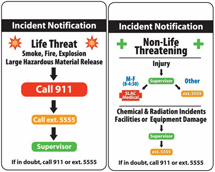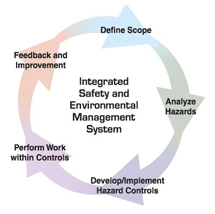Symmetry Explains it in 60 Seconds: E=mc2
by Peter Meyers, Princeton University
Einstein's famous equation says that mass (m) is equivalent to energy (E). The recognition that the two quantities are related was Einstein's stroke of genius. The speed of light squared (c2) comes into the equation to tell us exactly how much energy a given amount of mass represents.
In the world of subatomic processes, the mass of particles can change into energy in the form of light, heat or motion. Likewise, energy can also transform into mass. Particle accelerators exploit this idea by smashing together fast-moving particles. The high energy of these collisions transforms into new particles, which can have much greater mass than the ones that originally collided.
Converting mass into energy is the goal of scientists pursuing nuclear fusion. Fusing protons and neutrons together results in a nucleus with a total mass that is less than the mass of its constituents. The missing mass appears as energy, which can be harnessed—in principle—for useful power: E=mc2!
Mass-energy convertibility has far-reaching consequences. Your car's engine is powered by fossil fuel, which comes from prehistoric plants. The plants got their energy from sunlight, which was produced by nuclear fusion in the sun. So your car, and virtually all other activity on Earth, is ultimately powered by E=mc2.
Symmetry magazine is
available online.
|

Focus on Safety '08:
Incident Notification & Prevention
by Brian Sherin
 New badge cards will be distributed at this year's Focus on Safety meetings. (Click for larger image.)
New badge cards will be distributed at this year's Focus on Safety meetings. (Click for larger image.)
Between July 28 and August 15, SLAC department leaders will
conduct Focus on Safety sessions for all of their team members. A
similar event in July 2007 resulted in the identification of more than 240 safety
risks, and means to eliminate them, in 56 SLAC groups. (See "Maintaining our Focus.") This year's
session will focus on two areas: injury prevention and SLAC's new incident notification procedures.
During the first three quarters of this fiscal year, SLAC has experienced 29 incidents that were serious enough
to either cause injuries beyond first aid or require reports to the DOE.
Investigation of these incidents highlighted a potential for
improvement in our notification system and investigation program.
Together with the Department of Energy, SLAC's Environment, Safety & Health
division has been working to enhance the effectiveness of our incident response and
the quality of SLAC's investigations to identify root causes. As noted in the newly updated ES&H Policy,
it's a key goal to "learn from successes and deviations from expected outcomes, and encourage workers to both report these instances and provide feedback."
At this year's Focus on Safety meetings, everyone will receive new badge cards
(shown above) that describe
the emergency notification protocol. Supervisory personnel will also
receive a new badge card that describes the revised investigation process.
The meeting will include a collaborative session: "Brainstorming: Injury Prevention in Our Department." The results will be consolidated through a SLACspace
Web page,
created to provide ideas to the associate lab directors for continual improvement of the ES&H programs in each
directorate.
On Monday, department managers will receive specific instructions to access the materials for the department meetings.
A Dim GLAST?
Thanks to one SLAC Today reader for a tip: this weeks' GLAST flyovers,
at magnitude
7.5 and 7.6, could be too dim to see with the naked eye. If you don't
have binoculars, watch this site for a flyover with magnitude 6 or lower for the best sighting opportunities.
|
Happy Birthday, NASA
On July 29, 1958, the U.S. Congress passed legislation formally inaugurating the National Aeronautics and Space Administration (NASA). President Eisenhower commissioned T. Keith Glernan as the first administrator. Happy 50th!
Safety Review:
Analyzing Hazards
by Steven Frey
This article is the second in a five-part series examining each of the five
core functions of SLAC's Integrated Safety Management System. The core functions are hands-on tools to help you plan and conduct work in a safe manner. Their relationships are depicted
in this handy diagram:

Click for larger image.
Analyzing the potential hazards of a job, task or activity to be
undertaken is the second core function in the ISMS safe work cycle. ''Analyzing"
means first identifying and then evaluating the potential hazards associated
with a job, task or activity. Another way of expressing this is "What are the
risks of doing it?"
Take the example of a job identified yesterday under "Defining Scope":
welding a girder. Step back to see the whole task environment and identify the potential hazards. Hazards could include: thermal burns to the skin, ultraviolet burns to the retinas, ignition of nearby materials,
inhalation of metal fumes, and so on. Next, assess the potential severity of the hazards individually and together. Think also of hazards that might not exist at first but that could emerge as the job progresses, such as ergonomics.
Could the task create a physical stress that could cause you to slip, trip, fall, lose your grip on your equipment from fatigue,
or generate increasing noise that might hinder your hearing? Could brightening or dimming of workspace lighting hamper your vision?
Supervisors, please discuss this core function with your team members.
Ask them to take an example task and call out the risks that they perceive.
Doing this exercise as a group demonstrates how to enhance risk analysis through reinforcement and mutual support. This will be an important step toward leading
everyone at SLAC to think of safety as an integral part of the work day.
Tomorrow's article will discuss the third core function, "Developing and
Implementing Hazard Controls."
See the ISEMS Web site for more helpful hints. Please call Steve Frey (x3839) if you have any questions.
|
Lab Announcements
Community Bulletin Board
|






 <%
Response.AddHeader "Last-modified", getArticleDate()
'Response.AddHeader "Last-modified","Mon, 01 Sep 1997 01:03:33 GMT"
'Monday, December 06, 2010
%>
<%
Response.AddHeader "Last-modified", getArticleDate()
'Response.AddHeader "Last-modified","Mon, 01 Sep 1997 01:03:33 GMT"
'Monday, December 06, 2010
%>